Haben Sie schon einmal versucht, einen Ihrer WordPress-Beiträge zu öffnen, nur um von einem 404-Fehler begrüßt zu werden? Manchmal erleben wir das, wenn wir an unseren eigenen WordPress-Seiten arbeiten oder unseren Benutzern helfen
Dieser Fehler tritt auf, wenn Sie auf Ihren WordPress-Administrationsbereich und Ihr Blog zugreifen können, aber wenn Sie versuchen, einen bestimmten Beitrag zu öffnen, erhalten Sie die Meldung „404 Not Found“.
Es kann frustrierend sein, wenn Ihre Inhalte scheinbar verschwinden, aber wir haben einige Lösungen gefunden, um dieses Problem zu beheben. In dieser vollständigen Anleitung zeigen wir Ihnen, wie Sie WordPress-Beiträge mit 404-Fehlern beheben können.

Warum erhalten meine WordPress-Beiträge einen 404-Fehler?
Es gibt mehrere Gründe, warum Ihre Beiträge in WordPress einen 404 „Seite nicht gefunden“-Fehler anzeigen. Diese können sein:
- Konflikte mit Plugins oder Themes: Manchmal können Plugins oder Themes, die Sie auf Ihrer Website installiert haben, die Handhabung von Permalinks durch WordPress beeinträchtigen. Dies kann zu fehlerhaften Links und 404-Fehlern führen.
- Probleme mit benutzerdefiniertem Code: Wenn Sie Ihrer Website benutzerdefinierten Code hinzugefügt haben, kann es sein, dass der Code Fehler enthält, die sich auf Permalinks auswirken oder andere Konflikte verursachen, was zu 404-Fehlern für Ihre Beiträge führt.
- Probleme mit Ihrer .htaccess-Datei: Die .htaccess-Datei spielt eine Rolle dabei, wie WordPress URLs strukturiert. Wenn diese Datei beschädigt ist oder fehlt, kann dies zu 404-Fehlern für Ihre Beiträge oder Seiten führen.
Wie man alle WordPress-Beiträge mit 404-Fehlern findet
Bevor wir zu den Lösungen kommen, wäre es gut, herauszufinden, ob der Fehler nur bei einem oder zwei Beiträgen oder bei mehreren Beiträgen auftritt. Auf diese Weise können Sie den Umfang des Problems bestimmen und die am besten geeignete Lösung wählen.
Eine einfache Möglichkeit, dies herauszufinden, ist die Verwendung der Google Search Console. Wenn Sie Ihre Website noch nicht bei Google Search Console angemeldet haben, lesen Sie unseren Leitfaden zum Hinzufügen Ihrer WordPress-Website zu Google Search Console.
Sobald der Google-Bot Ihre Website gecrawlt und indexiert hat, liefert Ihnen die Google Search Console detaillierte Informationen über die Leistung Ihrer Website, einschließlich aller 404-Fehler, auf die sie stößt.
Um herauszufinden, bei welchen Beiträgen 404-Fehler auftreten, können Sie sich im Dashboard der Search Console anmelden. Navigieren Sie dann zum Bericht „Seiten“ und Sie sehen eine detaillierte Liste aller Fehler.
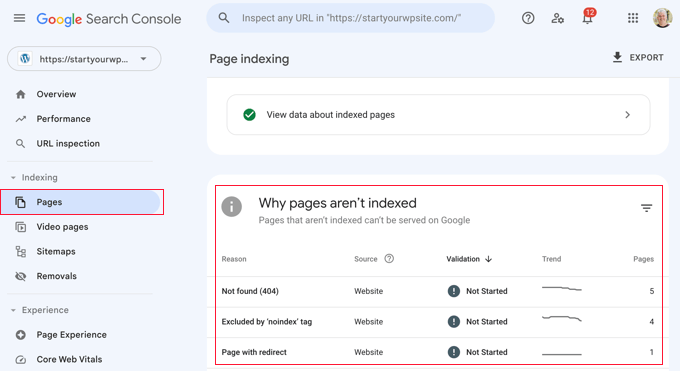
Weitere Informationen finden Sie in unserer Liste mit Tipps für die Verwendung der Google Search Console zur Steigerung des Website-Traffics, die auch einige Tipps zur Behebung von 404-Fehlern mit dem Tool enthält.
Sehen wir uns also an, wie man WordPress-Beiträge mit 404-Fehlern beheben kann. Sie können die Links unten verwenden, um direkt zu den verschiedenen Lösungen zu springen:
Keine Zeit, 404-Fehler selbst zu beheben? WPBeginner Pro Services kann helfen! Mit unserem erschwinglichen WordPress-Notfallsupport können Sie Experten beauftragen, 404-Fehler, defekte Links, Weiterleitungsprobleme und vieles mehr zu beheben. Hören Sie auf, sich über WordPress-Probleme zu ärgern und lassen Sie sie beheben! Vereinbaren Sie noch heute einen Notfall-Support für WordPress!
Methode 1: Suchen Sie nach Plugin- oder Theme-Konflikten und benutzerdefinierten Code-Problemen
Manchmal können Plugins, Themes oder benutzerdefinierter Code, den Sie zu Ihrer WordPress-Website hinzugefügt haben, Permalinks beeinträchtigen oder Konflikte verursachen, die zu 404-Fehlern führen. Wir haben das sogar schon selbst erlebt, als wir Tools auf unserer Demo-Website getestet haben.
Eine Möglichkeit, dieses Problem zu lösen, besteht darin, Plugins vorübergehend zu deaktivieren. Plugins können manchmal stören, wie WordPress mit Links umgeht.
Nachdem Sie die Plugins deaktiviert haben, können Sie sie nacheinander reaktivieren und dabei überprüfen, ob der 404-Fehler nach der Aktivierung der einzelnen Plugins erneut auftritt. Wenn der Fehler nach der Aktivierung eines bestimmten Plugins auftritt, könnte dieses der Übeltäter sein.
Sie können dann eine schnelle Google-Suche nach Lösungen für dieses Plugin durchführen oder den Plugin-Entwickler um Unterstützung bitten.
Auch Ihr WordPress-Theme könnte die Ursache für den Konflikt sein.
Um das zu überprüfen, können Sie vorübergehend zu einem Standard-WordPress-Theme wie Twenty Twenty-Three oder Twenty Twenty-Four wechseln. Dazu müssen Sie nur auf Darstellung „ Themes gehen und bei einem Standard-Theme auf „Aktivieren“ klicken.

Wenn der 404-Fehler mit dem Standard-Theme verschwindet, deutet dies auf einen möglichen Konflikt mit Ihrem aktuellen Theme hin. Sie können dann versuchen, das Problem mit dem Theme zu beheben oder ein anderes Theme zu verwenden.
In unserer Expertenauswahl der beliebtesten WordPress-Themes finden Sie Empfehlungen.
Wenn Sie kürzlich Codeschnipsel in Ihre Website eingefügt haben, kann es sein, dass der Code Fehler enthält, die die 404-Fehler verursachen. Schauen Sie sich den hinzugefügten Code genau an und prüfen Sie, ob Sie Fehler finden können.
Der sicherste Weg, Code-Schnipsel in WordPress einzufügen, ist das WPCode-Plugin. Mit diesem Plugin können Sie benutzerdefinierten Code einfügen, ohne direkt mit den Themadateien zu arbeiten, wodurch das Risiko, dass Ihre Website beschädigt wird, verringert wird.
Und wenn WPCode einen Fehler in Ihrem Code entdeckt, wird das Snippet automatisch deaktiviert und Sie werden aufgefordert, es zu überprüfen. Sie können auch den Testmodus verwenden, um zu prüfen, ob Ihr Code funktioniert, bevor Sie ihn auf Ihre Live-Website übertragen.

Wenn keine dieser Lösungen funktioniert, fahren Sie mit der nächsten Methode fort, bei der wir Ihre Permalink-Einstellungen überprüfen werden.
Methode 2: Reparieren Sie Ihre Permalink-Einstellungen
WordPress-Beiträge können aufgrund von Problemen mit Rewrite-Regeln in Ihrer .htaccess-Datei 404-Fehler zurückgeben. In den meisten Fällen können Sie das Problem beheben, indem Sie Ihre Permalink-Einstellungen aktualisieren.
Gehen Sie einfach zu Einstellungen “ Permalinks in Ihrem WordPress-Admin und klicken Sie auf die Schaltfläche „Änderungen speichern“.

Es ist nicht notwendig, die Permalink-Einstellungen selbst zu ändern. Dadurch werden Ihre Permalink-Einstellungen aktualisiert und die Rewrite-Regeln geleert.
In den meisten Fällen behebt diese Lösung den 404-Fehler bei WordPress-Beiträgen. Wenn es bei Ihnen jedoch nicht funktioniert, müssen Sie wahrscheinlich Ihre .htaccess-Datei manuell aktualisieren.
Methode 3: Aktualisieren der WordPress-.htaccess-Datei
Bevor Sie beginnen, sollten Sie eine Sicherungskopie Ihrer WordPress.htaccess-Datei erstellen. Wenn etwas schief geht, können Sie die ursprüngliche Datei leicht wiederherstellen.
Nun müssen Sie eine Verbindung zu Ihrem Server herstellen, indem Sie einen FTP-Client wie FileZilla oder die Dateimanager-App in Ihrem WordPress-Hosting-Dashboard verwenden.
Als Nächstes müssen Sie die Datei .htaccess finden und bearbeiten, die sich am selben Ort wie die Ordner /wp-content/ und /wp-includes/ befindet.
Klicken Sie einfach mit der rechten Maustaste auf die Datei und wählen Sie „Dateiberechtigungen“.
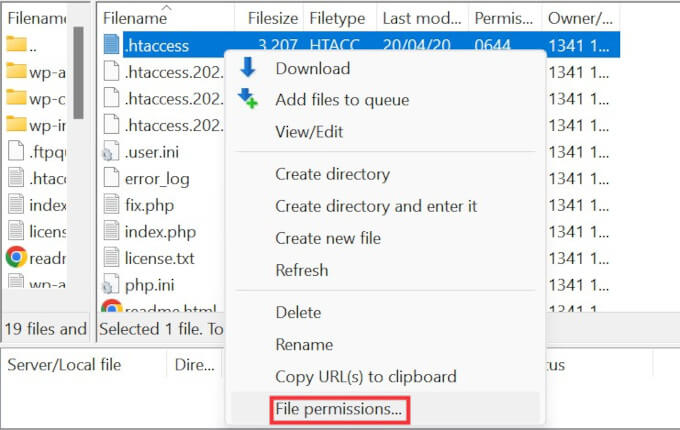
Sie können die Datei schreibbar machen, indem Sie ihre Berechtigungen auf 666 ändern.
Geben Sie einfach „666“ in das Feld „Numerischer Wert“ ein und klicken Sie dann auf „OK“.

Dann müssen Sie die Schritte der ersten Methode unseres Tutorials wiederholen. Vergessen Sie danach nicht, die Berechtigungen wieder auf 660 zu ändern.
Sie können die Datei auch bearbeiten und ihr Code hinzufügen.
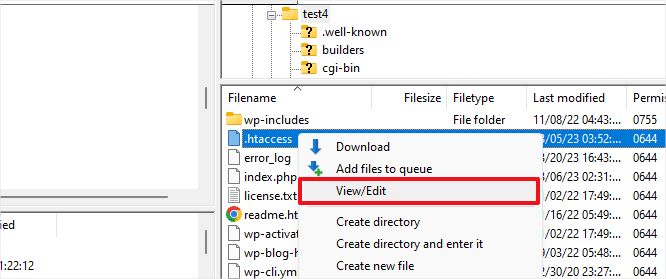
Nachdem Sie die .htaccess-Datei mit einem Texteditor geöffnet haben, fügen Sie einfach diesen Code ein:
# BEGIN WordPress
<IfModule mod_rewrite.c>
RewriteEngine On
RewriteBase /
RewriteRule ^index\.php$ - [L]
RewriteCond %{REQUEST_FILENAME} !-f
RewriteCond %{REQUEST_FILENAME} !-d
RewriteRule . /index.php [L]
</IfModule>
# END WordPress
Methode 4: Kontaktieren Sie Ihren Hosting-Anbieter
Wenn keine der oben genannten Lösungen das Problem der 404-Fehler bei WordPress-Beiträgen behoben hat, empfehlen wir Ihnen, sich an Ihren WordPress-Hosting-Anbieter zu wenden. Möglicherweise liegt ein Fehler auf dessen Seite vor, oder er kann Ihnen bei der Fehlerbehebung helfen.
Bitte lesen Sie auch unseren Leitfaden, wie Sie richtig nach WordPress-Support fragen und diesen auch erhalten.
Methode 5: Aktivieren Sie mod-rewrite (lokale WordPress-Installation)
Wenn Sie einen lokalen Server zu Testzwecken verwenden, müssen Sie mod_rewrite in der Apache-Konfiguration Ihrer MAMP-, WAMP- oder XAMPP-Site aktivieren.
Dies ermöglicht WordPress, saubere URLs zu generieren und den 404-Fehler für Beiträge und Seiten auf Ihrem lokalen Server zu vermeiden.
Wie Sie dies tun, hängt von der von Ihnen verwendeten Plattform ab. Benutzer von XAMPP können ihr Kontrollpanel öffnen und unter „Aktionen“ auf die Schaltfläche „Konfig“ klicken. Wählen Sie dann „Apache (httpd.conf)“.
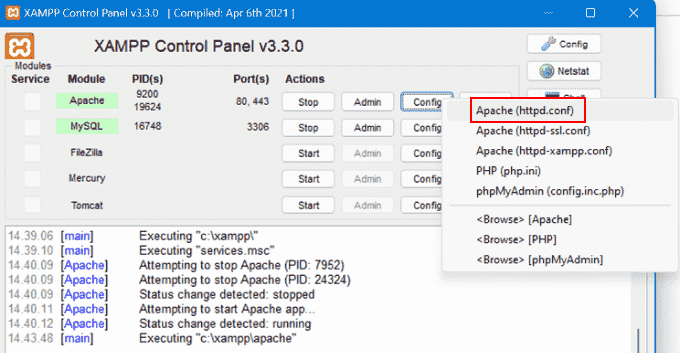
Als Nächstes müssen Sie diese Zeile #LoadModule rewrite_module modules/mod_rewrite.so finden und das ‚#‘ entfernen, um sie zu entkommentieren.
Dadurch wird mod_rewrite geladen.
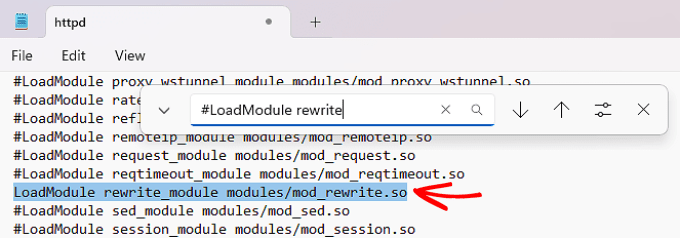
Suchen Sie dann alle Instanzen von AllowOverride None und ändern Sie sie in AllowOverride All.
Der Wert „Alle“ bedeutet, dass alle Direktiven überschrieben werden können.

Danach können Sie die Datei httpd.conf speichern und schließen. Danach klicken Sie im XAMPP-Kontrollfeld auf „Stop“ für das Apache-Modul und erneut auf „Start“, um es neu zu starten.
Gehen Sie dann zurück zu Ihrem Admin-Dashboard, um zu sehen, ob Ihre Permalinks funktionieren.
Video-Anleitung
Wenn Sie eine visuelle Anleitung benötigen, sehen Sie sich einfach das folgende Video an.
Wir hoffen, dass dieser Artikel Ihnen geholfen hat, die 404-Fehler in WordPress zu beheben. Vielleicht interessieren Sie sich auch für unseren Leitfaden zu den häufigsten WordPress-Fehlern und deren Behebung sowie für unsere Expertenauswahl der besten WordPress-Plugins für das Wachstum Ihrer Website.
Wenn Ihnen dieser Artikel gefallen hat, dann abonnieren Sie bitte unseren YouTube-Kanal für WordPress-Videotutorials. Sie können uns auch auf Twitter und Facebook finden.





Abs
It helps.. just on permalink, already fix my error..
Thanks for this article..
Julius
Mine is a little different. All the pages are working fine but I get „page not found“ when working in some places in the dashboard. Let’s say for example I’m creating a new page from the dashboard. When I click on publish I get a 404 error.
And I’ve tried everything above but it’s not working.
Iron65
Thanks for the tip!! the permalink really saved me!!! In case if any other suffered this by updating Yoast SEO or by just deleting cache, try that one, it will fix it
Monica
I have been trying to fix this permalink issue in my site for months and now I did it with your instructions. I don’t know why I did everything you said already and after writing the 644 permissions to fix the httaccess file, it went back to non-writeable. Now I did it and fixed the permissions and wrote your code and it worked. i really don’t know which was the difference but this time it did. Maybe that I already fixed the httaccess in the original folder where I have a subfolder with my blog. That is the only thing I did differently. Thanks a lot
Rais Dar
I am getting a 404(page not found) on my site. What should i do as i tried your methods but still error persists
Chetan
I had faced the same kind of problem. I used to get 404 Page Not Found error for a page. But the reason was that I and used a permalink slug that was associated with some default page in WordPress. e.g. http://example.com/posts – This is WRONG. Because I cannot use ‚posts‘ as permalink slug. It is already reserved for some WordPress page. When I changed it to ‚my-posts‘, so that now my permalink read: http://example.com/my-posts, the error was gone!
md
hi ,
i had same htaccess .,however , i delete it and import new one but still same .
dumb
hay guys ….
when i change the permalink to anything other than default, my pages wont work i get this error message
„The requested URL /wordpress/home/ was not found on this server.
Apache/2.4.9 (Win64) PHP/5.5.12 Server at localhost Port 80“
pl help me out
Ian Scofield
I just had this with one of my websites. All of my posts worked fine except for one though. Something was bad about the URL. I had to change the post URL.
neelesh
thanks a lot… ur website has helped me a lot of times and u guys are doing great job. i cant resist myself from thanking you…..
Hardik
Hi Wpbeginner,
Actually I just have migrated from hostinger to one of paid hosting. After migration all things are going good. But when I have tried to edit one my post it regularly shows the following error.
„Page not found error“ ‚Apologies, but the page you requested could not be found. Perhaps searching will help.
When I have landed here I have tried all the solutions which you have share.
But nothing is working for me.
Please Help.
Thanks in advance
Hardik
Adrienne
Question? I have an url site, but the data is all new. so there are about 100 old posts that are not longer valid but linked to other sites.. How do I change it to forward to main website, so that Google Search Console can update they crawl records.
I’m looking, but I don’t see anything for posts that have been deleted and getting a 404 error.
Thanks,
David
Thanks was having exactly that issue and this fixed it perfectly!
Mark
Thank you! So nice to find such an easy fix for such a frustrating mysterious problem.
Xavier
Woohoo! Thanks for this. I thought my site content had gone to the birds. Doing the permalink „Save Changes“ worked instantly for me.
Pablo
What if it doesn’t work no matter what you do?
HELP!
Fida
Hi Pablo Which server do you use? Shared server or VPS?
Steve Jackson
Thank you for this tip, it was a lifesaver and worked perfectly!
John
Thank you !!!!
abhishek
thank you very much it saved my links pretty well
Hugo Nascimento
Hello guys,
I have the same issue with a client blog. i’m trying to build a custom form inside post page and when I enable the custom permalinks, the form cannot be accessed.
When I change permalinks to default, it works out! :/
Really strange. :/
Sarah
Changing permalinks to default solved my problem too! Thank you!
mojamalenkost
Thank you so much!!!
victor
I have this problem .I can’t login to my WordPress dashboard, each time I try to it keeps giving me Error 404 not found. please help me fix this.
Dont Ask Real Name
Your tip was a life saver. All our posts were just not visible. Your tip helped a lot.
What i did:
Updated .htaccess set CHMOD to 666 instead of 660
Clicked – > Settings -> Permalinks
Clicked on Defaults and clicked Save Changes
Again,
Clicked on Post name and clicked on Save Changes. (since i used custom url that’s why)
You just saved me a ton of headache…
Clive Wales
That was a real life-saver – thought I’d totally screwed up a replacement site I’ve been working on, after trying to be clever with an .htaccess redirection. Thank you!
Marko Liuksiala
Great, that worked – thank you!!
Bill
I like the permalink structure of my posts and they seem to work. I have been using the same structure for several years.
However when I go to Settings–>Permalinks the actual structure is not even listed as one of the options available anymore.
Is this a problem?
Emily
Hi I am having this problem and to be honest, I feel sick because I don’t know what to do. I am a novice really and scared I am going to kill my website more than I already have.
Can someone please tell me what my custom permalink should look like and what I SHOULD hav in my .htaacess file? Right now it seems blank?
WPBeginner Support
Go to Settings » Permalinks choose a permalink structure that you like and then save your changes. Open your .htaccess file and you will notice that WordPress has automatically updated it. If it is blank and your chosen permalink structure is not working, then you can manually add this code into your .htaccess file:
# BEGIN WordPress
RewriteEngine On
RewriteBase /
RewriteRule ^index\.php$ – [L]
RewriteCond %{REQUEST_FILENAME} !-f
RewriteCond %{REQUEST_FILENAME} !-d
RewriteRule . /index.php [L]
# END WordPress
Admin
Viktor
Yes, that was the solution! Thanks a lot. My hosting service changed these settings as I changed the URL to custom error pages but just clicking on the permalink settings fixed that.
Matthew Shelton
„Go to Settings » Permalinks, and simply click on Save Changes button“ – fantastic, that worked right away – thanks a lot!!
WPBeginner Staff
Check the .htaccess file.
Gretchen Louise
What about for a single post permalink that got changed and somehow created an internal redirect, and now it cannot be changed back without creating a 404 error? Trying to troubleshoot an issue for a client and wondering where those internal redirects are stored and where in the world to clear them. Thank you.
Thembi Ngema
Dudessss. You guys are legends :)…. Must say I have learnt a lot from you in the past week
bhupendra
hi
thanks I just updated parmalinks structure and site started working
Arpee Lazaro
i just updated t he permalink structures are pictured in this solution and it worked like a charm. thanks!
WPBeginner Staff
Please contact your web host.
Attiq Haroon
I tried the solutions you mentioned in you post bhut it didn’t seems to be working. What happened actually is that I wanted to add a rule to .htaccess file so I downloaded that files from FTP and edited it and uploaded that file again replacing the original one, and then the problem popped up. I have tried a couple of fixes such as deleting and putting new .htacces with default code, removing .htacces file, etc. The only fix that is making the posts accessible is to set the permalink to default option. This makes the posts to work but it can not be a permanent Fix as it is not recommended as an SEO prespective
Please try to find a working solution on that problem
WPBeginner Staff
backup your .htaccess file. Then delete the one from your server. Now log into WordPress admin area and go to Settings -> Permalinks choose your desired permalink structure and hit save changes.
After that connect to FTP and see if WordPress has created a new .htaccess file and it is not blank.
Attiq Haroon
I tried that solution, It created a .htaccess file which looks fine but doesn’t work.
gui
If you have Yoast WordPress SEO or any SEO plugin installed, check your SEO permalink section…
Tim Topham
Hey guys – I recently received an email from Google crawl as I suddenly had a heap 500+ of lost links. It seems that at some stage I must have changed the permalink structure so that lots of the links on old posts have the post date and then post name where as they now just have the post name.
Before I go mad trying to fix 500 links in my articles manually, is there an easy way to update the hyperlinks in articles when this sort of thing happens?
Cheers,
Tim.
Manuel Moreira
I was going insane with this 404 thing after a server move. Thanks for the help guys.
Cindy
thank you! My sites were hacked and all internal pages showed a 404 error. saving the permalink settings fixed it! cheers!
Joe Cutroni
Hi all, I’ve scoured the web to find help to resolve my issue, but
for the life of me cannot get anything to work. Starting just a couple
of weeks ago, all of my back end pages (home page was fine) started
turning out 404 errors on them.
The permalink that I have always used is „Custom structure“ (/%category%/%postname%/)…here are some things that I’ve tried:
1 . Gone into my permalinks, clicked „save settings“, and that method provides a temporary fix, maybe for an hour or two, then the 404 errors return on all secondary pages. I’ve also set my permalinks to a different option, such as „Default“, but still get 404 errors shortly after.
2. Completely deleted my htaccess.php file, then went back and saved permalink settings…less than an hour later, 404 errors returned.
3. Commented out this line of code in my function.php file, also completely removed it altogether:
„$wp_rewrite->flush_rules();“. That didn’t do anything. I’ve tried
using both „//“ and „#“ before it and tested…still get 404 errors.
4. De-activated all of my plugins to see it one of them was the culprit,
but after a short time, my 404 errors resumed while none of the plugins were active.
Like I said, this issue just start a few weeks ago. I use Securi
Security and had them scan my site for any malware, etc…and the site
is clean.
Can someone PLEASE help me with this? Would bigtime appreciate it!
Kyle
Hey Joe,
Did you ever find a workable solution for this? I’ve gone through the same issues that you listed.
David
Hey Guys!
Did you find a solution to the returning 404-error as listed above by JOE CUTRONI?
I’m dealing with the same issue?
Some Feedback would be awesome!
Thank you!
Greetings from Germany,
David
Paul
Hey guys,
you are likely to have a virus on your site.
good luck
Paul
Katie
This is the problem I am having. I moved from Wordpress.com to .org and I am at my wits end. I understand the directions that say got admin—> settings —> permalinks. In fact, I remember when I was setting this up that I messed with that particular setting. Here’s my issues: WHERE do I find this admin–> settings–> permalinks?? Is it on my host, in the cpanel? Is it back on WP.com, or if it’s WP.org? And if it’s on WP.org I don’t have a clue how to get to all the admin features of my blog now. When I log in, it shows me my personal profile and allows me to edit it. But not any blog administration. I am at a loss and really losing my head.
Gabriel
If I’m understanding you correctly, just type in the domain name that you activated the wp.org tool and follow it up with „/wp-admin“ (for instance „www.example.com/wp-admin“)log in and on the lower left hand side you would find the settings option.
mali suresh
how can change localhost paramalink step by step help me
Srihari K
I had the same problem.. adding the below line in httpd.conf and restarting apache fixed it.
Options +FollowSymLinks
Kym Penrose Clayton
Thank you thank you thank you
Iris Fritschi-Cussens
THANK YOU from the bottom of my heart! I had to delete my .htaccess file due to a hack and then just when I thought everything was fine again nothing worked apart from the home page. Pressing Save Changes on the permalinks solved it in one.
disqus_Hct2NXneXJ
Thanks Man. The Permalink Solution Fixed my Problem. Thanks & Cheers for You!
MEMEME
Thanks! You are God.
L
thanks! I was close to panic…
Thai
Thanks for the post! But sadly I tried these with on the local and nothing worked.. Any other tips?
SemLavana
Thank you. Saved my weekend!